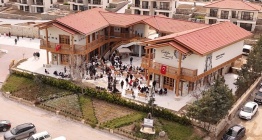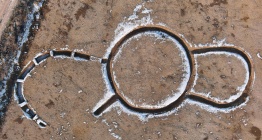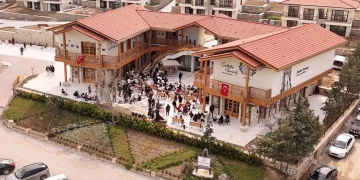Geology students are working on the NASA science team, to explore Jezero Crater near an ancient river delta that might hold clues of the first known extraterrestrial life. Jezero Crater lies next to what scientists believe to be an ancient river delta. On Earth, these are likely places to harbor evidence of ancient life since organic life would get swept downstream to this standing water where it quickly would get covered over and preserved in fine sediment.
The first year of the Perseverance rover mission on Mars captured the imaginations of scientists and the public alike with an interplanetary helicopter flight and the first chance to hear the sounds of the red planet.
But two doctoral students at the University of Cincinnati say the best is yet to come in year two as the rover and their Perseverance science team begin in earnest to look for ancient life on another planet.
UC College of Arts and Sciences geology students Desirée Baker and Andrea Corpolongo are working on the NASA science team, using the rover and its helicopter sidekick, Ingenuity, to explore Jezero Crater near an ancient river delta that might hold clues of the first known extraterrestrial life.
UC associate professor Andy Czaja served on the NASA advisory board that picked where to send the rover for the best chance to find evidence of ancient life. Now he and his two students are members of the mission science team helping NASA explore the red planet to answer fundamental questions about the origins of life in the universe.
One fundamental task of the mission: collect rock samples on the Martian surface to bring back to Earth during a future mission.
Czaja is one of 16 scientists around the world named in June to a new NASA science group that will plan how the global scientific community will share and study those samples. The team includes experts in geology, geochemistry, planetary physics and epidemiology, among others.
"Mars is at the frontier of science. I'm excited and honored to be part of it," said Czaja, who studies Precambrian paleobiology, astrobiology and biogeochemistry.
Baker and Corpolongo work shifts as tactical documentarians, taking notes on daily decisions and their rationales to help the hundreds of other science team members stay informed and get back up to speed when they are not working. In particular, Baker documents decisions and discussions about an instrument called SHERLOC that uses cameras, spectrometers and a laser to search for signs of past microbial life on Mars.
"Each day on Mars is called a sol. For each day's planning, we document what the pilot and scientists have in store for the next sol," Baker said.
The science team has a strong spirit of exploration, she said.
"It's mind-blowing to think about," she said. "You're exploring another planet, looking at things never before seen until now and helping to interpret and share them."
The rover conducts tasks in both daylight and darkness, so science team members work unusual hours during the Martian sol, which is 37 minutes longer than Earth's 24-hour day.
Corpolongo also serves as a campaign implementation documentarian, which plans out the mission two days in advance of the tactical team.
"That team will set up a plan for two sols in advance if everything goes perfectly," Corpolongo said. "Then starting each tactical shift, you look at the previous campaign implementation documentarian report to get that high level picture of what's going on today."
Typically, the rover's itinerary and objectives go as planned, but when there are surprises or challenges, the campaign implementation team adjusts accordingly, she said.
"I call it a science party. It is hard for me to put into words how cool it is to be part of this international mission with eyes all over the world on it," Corpolongo said.
Baker said after its historical flights proved successful, the helicopter Ingenuity is serving as an advance scout for Perseverance, helping to identify potential pitfalls and intriguing rocks on its designated route.
"That's been an unexpected bonus for Ingenuity. Now we're finding new ways to use it," Baker said. "The rover has to be careful where it drives. It's a desert environment with soft sand."
Czaja said he doesn't know if Perseverance will find evidence of ancient life on Mars. But he has confidence in the rover's ability to look for it. And the location NASA selected for the search is promising, he said.
Jezero Crater lies next to what scientists believe to be an ancient river delta. On Earth, these are likely places to harbor evidence of ancient life since organic life would get swept downstream to this standing water where it quickly would get covered over and preserved in fine sediment.
"It looked like a river delta from orbit, but there are things you can't see from orbit that we have now that demonstrate this was, in fact, a delta," Czaja said.
If Perseverance does find what looks to be tangible evidence of ancient life, confirmation likely will have to wait until a return mission to retrieve the samples the rover collects. These analyses are bound to reveal other surprises back on Earth.
"That's one of the great things about sample return. You're not just doing it to answer the questions we have today," Czaja said. "There may be questions nobody has even thought of yet. The person who thinks of that question might not have been born yet."
Perseverance has celebrated a series of successes from its launch to its touchdown on Mars seven months later via a Skycrane, a rocket-powered descent vehicle that lowered the rover to the surface via cables. Before the launch, NASA engineers described the spacecraft's final descent through the thin Martian atmosphere as "seven minutes of terror."
Czaja and other members of the science team tuned in to the JPL livestream to watch as they learned of the spacecraft's fate, deploying its parachute, jettisoning its heat shields and lowering the rover by cables onto the Martian surface.
"Watching the landing, I remember being too excited to sit down," Czaja said. "My heart was in my throat. Suddenly, a picture shows up of the underside of the rover and its surroundings on Mars."
Perseverance was ready to explore.
"There is a really big question if we find evidence of ancient life on Mars. Is it the same as ancient life on Earth? Did life on both planets have the same origins?" Corpolongo said. "There are so many questions."
In the first year of the mission, Czaja got a chance to name a geographic feature on Mars in accord with the naming conventions established for each mapped quadrant. NASA created a list of approved names associated with national parks around the world. One quadrant was associated with Verdon Natural Regional Park in France so Czaja named a ridge Mount Gourdan for a feature in the Alps.
"It's been pretty exciting. When you're working day to day, you lose sight of that a little bit. But when you step back, it makes you think, 'This is really exciting,'" Czaja said.
Czaja said it's been fun to contribute to the decision-making on the mission. Every choice has costs, risks and benefits that must be considered, he said.
"We're a bunch of scientists so we like to argue the merits of our ideas," he said. "There is so much we'd like to explore. You want to be as efficient as possible and meet all the goals of the mission in the time allotted."
Many things can go wrong in a mission as complicated as this undertaking, so each day's work is precious, presenting tantalizing scientific possibilities, Czaja said.
"You'll never know if you stop looking. It might be around the next bend or over the next hill," Czaja said.
Source: University of Cincinnati








 Tanrıları Taştandı
Tanrıları Taştandı  Avustralyalılar Anzak Günü'nde Lone Pine Anıtı'nda anma töreni düzenlendi
Avustralyalılar Anzak Günü'nde Lone Pine Anıtı'nda anma töreni düzenlendi  Heritage İstanbul Fuarına gelen ziyaretçilere Aizanoi NFT'leri hediye edilecek
Heritage İstanbul Fuarına gelen ziyaretçilere Aizanoi NFT'leri hediye edilecek  BAKSEV Ulusal Egemenlik Bayramına bir Etnografya, bir Çocuk Oyuncakları Müzesi armağan etti
BAKSEV Ulusal Egemenlik Bayramına bir Etnografya, bir Çocuk Oyuncakları Müzesi armağan etti 




